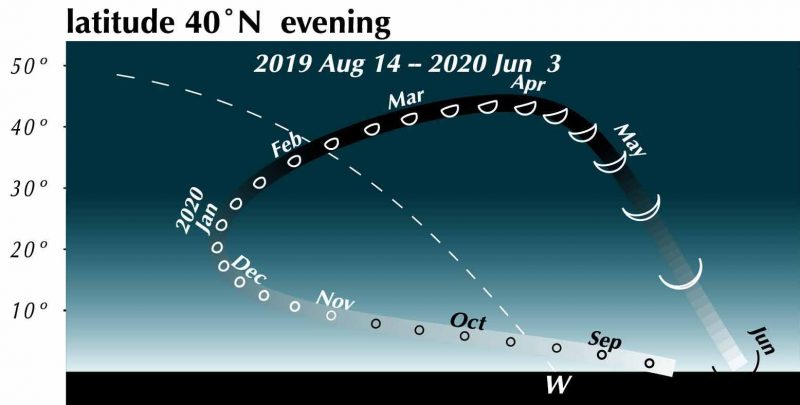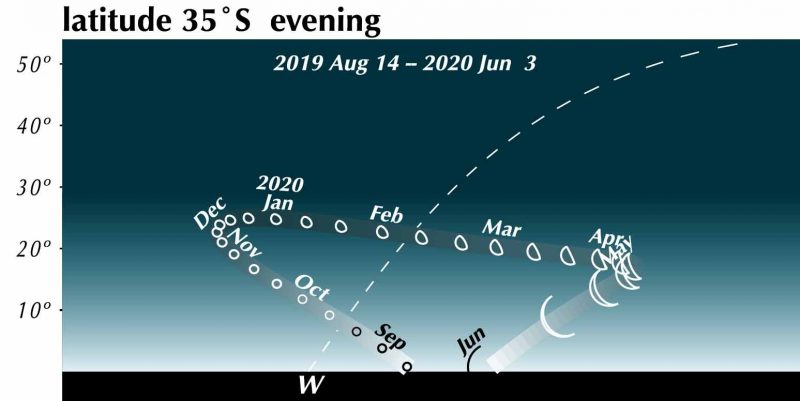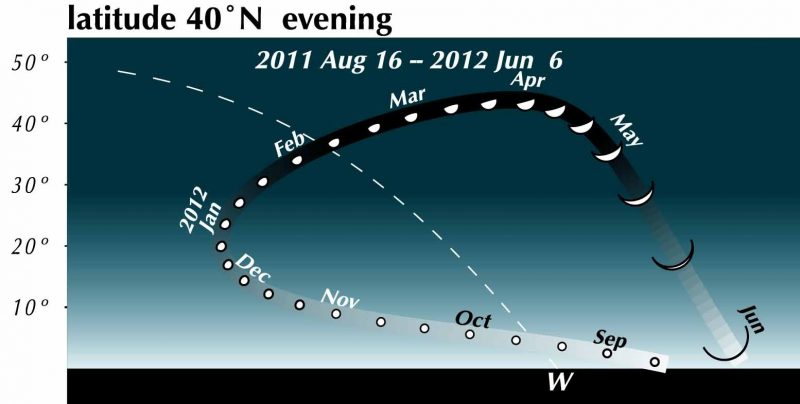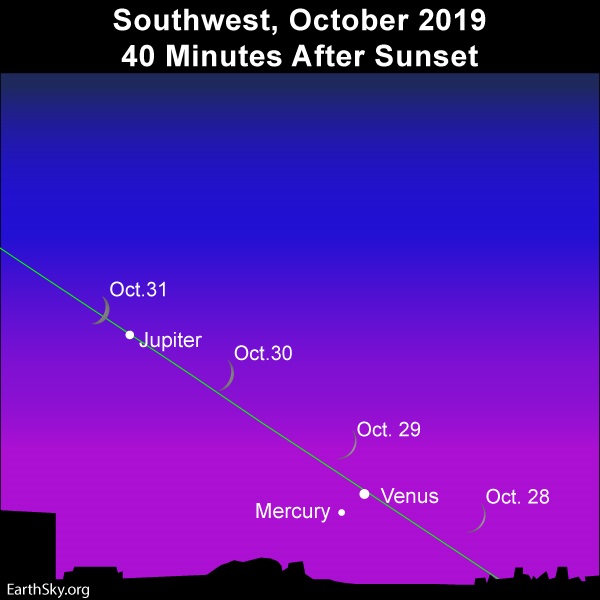

View larger. | Chart by Guy Ottewell, and via his blog.
Reprinted with permission from Guy Ottewell’s blog.
Venus is creeping out into a great evening apparition from August 2019 to June 2020. It’s of the type that – as Eric David reminded us in his comment on my October 12 post – will end with a very close passage in front of the sun: the close passage that produced the famous Venus transits of the past. The chart above shows Venus as it appears above the sunset horizon over the whole of this evening apparition, as seen from latitude 40 degrees north.
The sunlit disks of Venus are exaggerated 480 times in size, otherwise they would all be dots too small to see. You can think of each as what you would see through your binocular or telescope.
And here is how the same scene will appear, very differently, from 35 degrees south, a latitude roughly suiting Buenos Aires, South Africa, Australia, and New Zealand:

View larger. | Chart by Guy Ottewell, and via his blog.
The dashed line is the celestial equator, which for northern locations slopes up leftward from the sunset horizon, rightward for southern locations. No other features, such as the sun, stars, or the ecliptic, can be included, because in diagrams of this kind, based on altazimuth difference from the west point on the horizon, they are in different positions for every date. Venus is always on or near the ecliptic.
This type of apparition occurred eight years ago, and 16, and so on, in the eight-year Venus cycle. And in those two previous incarnations it resulted in the transits.
Here is the apparition that began eight years back from now:

View larger. | Chart by Guy Ottewell, and via his blog.
The Venuses are at slightly different points along the path, because I choose to show them at days 1, 11, and 21 of each month. The path itself seems identical – on this small scale. But it isn’t quite. In June 2012 it crossed the northern half of the Sun. In June 2019, it will pass slightly farther north, missing the Sun. No more Venus transits, till they begin again with a very marginal one in 2117.
In this picture the Venus shapes are filled, instead of being outlines. I could use advice on which style you find clearer.
Editor’s Note: But all of us should be able to see Venus by late October, when the waxing crescent moon will sweep near it in the sky, as shown on the chart below:

The young moon will swing through in the vicinity of the planets Mercury, Venus and Jupiter in late October 2019. The above chart is for North American mid-northern latitudes. Click here for more information plus a Southern Hemisphere sky chart.
Bottom line: The bright planet Venus will appear between October 2019 and June 2020. Its changing size and phase can be seen through binoculars or a small telescope.
See this same sky scene animated: Venus from late 2019 to early ’20
from EarthSky https://ift.tt/2IRF8s2


View larger. | Chart by Guy Ottewell, and via his blog.
Reprinted with permission from Guy Ottewell’s blog.
Venus is creeping out into a great evening apparition from August 2019 to June 2020. It’s of the type that – as Eric David reminded us in his comment on my October 12 post – will end with a very close passage in front of the sun: the close passage that produced the famous Venus transits of the past. The chart above shows Venus as it appears above the sunset horizon over the whole of this evening apparition, as seen from latitude 40 degrees north.
The sunlit disks of Venus are exaggerated 480 times in size, otherwise they would all be dots too small to see. You can think of each as what you would see through your binocular or telescope.
And here is how the same scene will appear, very differently, from 35 degrees south, a latitude roughly suiting Buenos Aires, South Africa, Australia, and New Zealand:

View larger. | Chart by Guy Ottewell, and via his blog.
The dashed line is the celestial equator, which for northern locations slopes up leftward from the sunset horizon, rightward for southern locations. No other features, such as the sun, stars, or the ecliptic, can be included, because in diagrams of this kind, based on altazimuth difference from the west point on the horizon, they are in different positions for every date. Venus is always on or near the ecliptic.
This type of apparition occurred eight years ago, and 16, and so on, in the eight-year Venus cycle. And in those two previous incarnations it resulted in the transits.
Here is the apparition that began eight years back from now:

View larger. | Chart by Guy Ottewell, and via his blog.
The Venuses are at slightly different points along the path, because I choose to show them at days 1, 11, and 21 of each month. The path itself seems identical – on this small scale. But it isn’t quite. In June 2012 it crossed the northern half of the Sun. In June 2019, it will pass slightly farther north, missing the Sun. No more Venus transits, till they begin again with a very marginal one in 2117.
In this picture the Venus shapes are filled, instead of being outlines. I could use advice on which style you find clearer.
Editor’s Note: But all of us should be able to see Venus by late October, when the waxing crescent moon will sweep near it in the sky, as shown on the chart below:

The young moon will swing through in the vicinity of the planets Mercury, Venus and Jupiter in late October 2019. The above chart is for North American mid-northern latitudes. Click here for more information plus a Southern Hemisphere sky chart.
Bottom line: The bright planet Venus will appear between October 2019 and June 2020. Its changing size and phase can be seen through binoculars or a small telescope.
See this same sky scene animated: Venus from late 2019 to early ’20
from EarthSky https://ift.tt/2IRF8s2

Aucun commentaire:
Enregistrer un commentaire